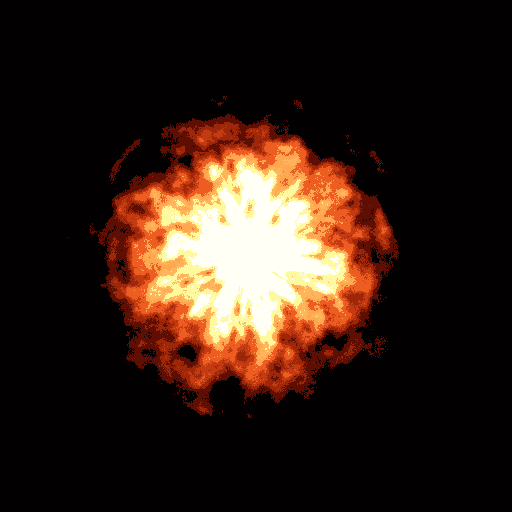Shader with SFML
In this tutorial I will show you how to make and use a fragment shader with SFML.
The goal is not to learn GLSL but to integrate a shader taken from Shadertoy or GLSL Sandbox into an SFML apps.
At the end of the tutorial you will have:
The Shader
Here is the code of the shader we will use:
#ifdef GL_ES
precision mediump float;
#endif
uniform float time;
uniform vec2 mouse;
uniform vec2 resolution;
float snoise(vec3 uv, float res)
{
const vec3 s = vec3(1e0, 1e2, 1e3);
uv *= res;
vec3 uv0 = floor(mod(uv, res))*s;
vec3 uv1 = floor(mod(uv+vec3(1.), res))*s;
vec3 f = fract(uv); f = f*f*(3.0-2.0*f);
vec4 v = vec4(uv0.x+uv0.y+uv0.z, uv1.x+uv0.y+uv0.z,
uv0.x+uv1.y+uv0.z, uv1.x+uv1.y+uv0.z);
vec4 r = fract(sin(v*1e-1)*1e3);
float r0 = mix(mix(r.x, r.y, f.x), mix(r.z, r.w, f.x), f.y);
r = fract(sin((v + uv1.z - uv0.z)*1e-1)*1e3);
float r1 = mix(mix(r.x, r.y, f.x), mix(r.z, r.w, f.x), f.y);
return mix(r0, r1, f.z)*2.-1.;
}
void main( void ) {
vec2 p = gl_FragCoord.xy / resolution.xy;
p.x = p.x - mouse.x / resolution.x;
p.y = p.y + mouse.y / resolution.y;
p.y = p.y - 1.0;
p.x*=resolution.x/resolution.y;
float color = 3.0 - (6.*length(p));
vec3 coord = vec3(atan(p.x,p.y)/6.2832, length(p)*0.4, .5);
for(int i = 1; i <= 7; i++){
float power = pow(2.0, float(i));
color += (1.5 / power) * snoise(coord + vec3(0.,-time*.05, time*.01), power*16.);
}
gl_FragColor = vec4( color, pow(max(color,0.),2.)*0.4, pow(max(color,0.),3.)*0.15 , 1.0);
}
As you can see there is a lot of mathematics involved when we want to make a shader with some blur or in this case noise.
Another interesting things are the parameters we will need to give to the shader:
uniform float time;
uniform vec2 mouse;
uniform vec2 resolution;
time = the time elapsed since the beginning of the program (in seconds).
mouse = coordinate (x, y) of the cursor (in pixel).
resolution = resolution of the window (in pixel).
The Shader with SFML Apps
Now we need to create the window and load the shader in the main. We will need to create a sprite to display the shader. And after that we will update the shader paramaters. Here is the source code.
#include <SFML/Graphics.hpp>
#include <iostream>
int main() {
const float winW = 800;
const float winH = 600;
sf::RenderWindow window(sf::VideoMode(winW, winH), "SFML Shader Example");
window.setMouseCursorVisible(false); // hide the cursor
// Create a texture and a sprite for the shader
sf::Texture tex;
tex.create(winW, winH);
sf::Sprite spr(tex);
sf::Shader shader;
shader.loadFromFile("fire.glsl", sf::Shader::Fragment); // load the shader
if (!shader.isAvailable()) {
std::cout << "The shader is not available\n";
}
// Set the resolution parameter (the resoltion is divided to make the fire smaller)
shader.setParameter("resolution", sf::Vector2f(winW / 2, winH / 2));
// Use a timer to obtain the time elapsed
sf::Clock clk;
clk.restart(); // start the timer
while (window.isOpen()) {
// Event handling
sf::Event event;
while (window.pollEvent(event)) {
// Exit the app when a key is pressed
if (event.type == sf::Event::KeyPressed)
window.close();
}
// Set the others parameters who need to be updated every frames
shader.setParameter("time", clk.getElapsedTime().asSeconds());
sf::Vector2i mousePos = sf::Mouse::getPosition(window);
shader.setParameter("mouse", sf::Vector2f(mousePos.x, mousePos.y - winH/2));
// Draw the sprite with the shader on it
window.clear();
window.draw(spr, &shader);
window.display();
}
return 0;
}
You can download the project shader with SFML for VS2015: SFMLShaderExample.7z